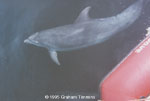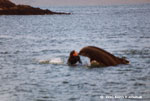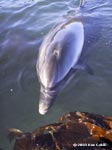 The focus of this website is on those cetaceans which particularly seek out human company. In European waters at this time, that means in effect bottlenose dolphins. In general these are ‘solitary’ animals, which are living alone rather than in a social group and often in a restricted area rather than moving around. Dolphins in general are gregarious and active animals, living in family groups sometimes known as pods and roaming over fairly wide tracts of ocean. Dolphin society is complex, however, and allows for much variation. Mature males in particular may split up into ones and twos and roam far from their maternal pods, so dolphins are not always seen in groups, although that is certainly more typical around the west of Ireland. However, what is unusual is for a solo dolphin to adopt a small fixed home range. Fungie would be the extreme example of this, both in time and space, but there is an infinite gradation in dolphin 'solitariness' which may include a substantial amount of contact with other dolphins. Dony moves around a lot and has spent most of the winter in recent years with another dolphin known as Jean F'loch. Venus was only 'solitary' for a few months in 2005. Dusty spends a lot of time with human companions but also regularly meets other dolphins. It is often hard to tell just how much or how little time a dolphin spends with conspecifics; we saw tooth-rake marks on Fungie for three years before we saw him meeting other dolphins, depsite constant almost daily observation. We therefore prefer now to think in terms of interactive dolphins rather than 'solitary', 'sociable' or 'solo' dolphins. The focus of this website is on those cetaceans which particularly seek out human company. In European waters at this time, that means in effect bottlenose dolphins. In general these are ‘solitary’ animals, which are living alone rather than in a social group and often in a restricted area rather than moving around. Dolphins in general are gregarious and active animals, living in family groups sometimes known as pods and roaming over fairly wide tracts of ocean. Dolphin society is complex, however, and allows for much variation. Mature males in particular may split up into ones and twos and roam far from their maternal pods, so dolphins are not always seen in groups, although that is certainly more typical around the west of Ireland. However, what is unusual is for a solo dolphin to adopt a small fixed home range. Fungie would be the extreme example of this, both in time and space, but there is an infinite gradation in dolphin 'solitariness' which may include a substantial amount of contact with other dolphins. Dony moves around a lot and has spent most of the winter in recent years with another dolphin known as Jean F'loch. Venus was only 'solitary' for a few months in 2005. Dusty spends a lot of time with human companions but also regularly meets other dolphins. It is often hard to tell just how much or how little time a dolphin spends with conspecifics; we saw tooth-rake marks on Fungie for three years before we saw him meeting other dolphins, depsite constant almost daily observation. We therefore prefer now to think in terms of interactive dolphins rather than 'solitary', 'sociable' or 'solo' dolphins.
 All dolphins tend to bow-ride boats which are going the way they want to go and in this sense may be said to associate with human beings. In some parts of the world, dolphins also feed in association with human fishing activity. Interactive dolphins, however, are distinguished by seeking out human activities which appear to have no direct benefit to them, and which in fact appear to put them into serious risk of ill health or injury. They may follow pleasure craft very closely, even when driven randomly or in circles, they may swim into shallow and polluted waters in harbours or river estuaries, and most conspicuously of all, they may approach human swimmers and divers and even allow people to touch them. All of these interactions are most definitely not normal for wild dolphins. ‘Normal’ wild dolphins may approach divers or swimmers in the water out of curiosity but nearly always pass by well underwater and out of reach. All dolphins tend to bow-ride boats which are going the way they want to go and in this sense may be said to associate with human beings. In some parts of the world, dolphins also feed in association with human fishing activity. Interactive dolphins, however, are distinguished by seeking out human activities which appear to have no direct benefit to them, and which in fact appear to put them into serious risk of ill health or injury. They may follow pleasure craft very closely, even when driven randomly or in circles, they may swim into shallow and polluted waters in harbours or river estuaries, and most conspicuously of all, they may approach human swimmers and divers and even allow people to touch them. All of these interactions are most definitely not normal for wild dolphins. ‘Normal’ wild dolphins may approach divers or swimmers in the water out of curiosity but nearly always pass by well underwater and out of reach.
It appears that over the last 30 years there have been more and more cases of human-dolphin interactions. In Ireland especially, the trend has been dramatic over the last five years, with up to four actively interacting solo dolphins in the country at one time. We don't believe that this trend can entirely be accounted for by greater human awareness or better reporting of incidents, though the rise in watersports such as scuba diving and surfing and the much wider availability and use of wetsuits associated with this development has doubtless played a role. But there seems to be no getting away from the fact that, for whatever reason, in this part of the world at least, more dolphins are making contact with more people. This has extended also to members of fully 'normal' wild pods of bottlenose dolphins, who in numerous incidents have made deliberate close approaches to people in the water, as well in boats; we have been lucky enough to enjoy many such encounters ourselves. Nevertheless, by far the majority of interactions have taken place with one dolphin at a time.
The scientific community, by and large, is not interested in solitary dolphins, and especially not when they become media celebrities, precisely because these animals are atypical of the species as a whole. The leading international marine mammal on-line discussion group, MARMAM, specifically forbids mention of human-dolphin interactions in its forum (except if this takes place within a dolphinarium!). Another major forum, the European Cetacean Society, treats the sociable dolphin phenomenon only from the point of view of it being a threat to dolphins. Whilst we agree that interactive dolphins are in many ways aberrant in terms of the species as a whole, we think it absurd to conclude from this that we cannot learn much of value from studying them - even much of value in conventional biological terms. (To one simple example, our tracking of Dony the Dunquin dolphin on his thousands of kilometres-long odyssey to France and England in 2001, which was possible only because of his exceptionally interactive behaviour, effectively shattered previous assumptions about bottlenose dolphins' ranging behaviour and set vastly increased new upper limits to the size of ranges which must in future be defined in relation to any proposed conservation measures). Nevertheless, very few marine biologists will yet go on record, whatever they privately believe, as saying that we could learn something from swimming with interactive wild dolphins - let alone that they might actually enjoy the experience themselves!
 This theme extends also to the statements issued by the main dolphin conservation groups. The Irish Whale and Dolphin Group (IWDG) and the UK Whale and Dolphin Conservation Society (WDCS) both publicly discourage anyone from interacting with wild dolphins, although many of their members seem to ignore this injunction themselves in practice. Often the officers of these societies are driven by a genuine love for dolphins and desire to hang out with them. Why else, indeed, would they be so motivated as to spend many hours each week of their time in observing dolphins and promoting their appreciation and protection, often unpaid or on expenses only? However, the voluntary conservationists are rarely academics or otherwise qualified themselves and are often anxious to seek the approval and co-operation of the 'official' experts, so they tend to sound more distant, more 'scientific' and less involved emotionally than they really are. At the same time there is a certain kudos and authority which comes from being the person to whom the local media turn for quotes when a friendly dolphin turns up in one's local area, not to mention from sitting on 'management committees' and 'steering groups' along with the harbour authorities, local police etc, and there can also be useful grants available to those who know the right people and can be trusted not to rock the boat. As a result, the conservation groups join the academics and council officials in condemning people who actually admit to enjoying swimming with dolphins (even if they privately do the same themselves)! This theme extends also to the statements issued by the main dolphin conservation groups. The Irish Whale and Dolphin Group (IWDG) and the UK Whale and Dolphin Conservation Society (WDCS) both publicly discourage anyone from interacting with wild dolphins, although many of their members seem to ignore this injunction themselves in practice. Often the officers of these societies are driven by a genuine love for dolphins and desire to hang out with them. Why else, indeed, would they be so motivated as to spend many hours each week of their time in observing dolphins and promoting their appreciation and protection, often unpaid or on expenses only? However, the voluntary conservationists are rarely academics or otherwise qualified themselves and are often anxious to seek the approval and co-operation of the 'official' experts, so they tend to sound more distant, more 'scientific' and less involved emotionally than they really are. At the same time there is a certain kudos and authority which comes from being the person to whom the local media turn for quotes when a friendly dolphin turns up in one's local area, not to mention from sitting on 'management committees' and 'steering groups' along with the harbour authorities, local police etc, and there can also be useful grants available to those who know the right people and can be trusted not to rock the boat. As a result, the conservation groups join the academics and council officials in condemning people who actually admit to enjoying swimming with dolphins (even if they privately do the same themselves)!
Thus when we seek to understand the point of view of those who criticise our choices, we should not look only for rational arguments, as these can be deceptive. One such argument does however deserve to be taken seriously. Gérard Mauger of the (GECC)group based in Cherbourg, France, which efficiently plotted the movements of Dony when he was in the Normandy area in the winter of 2001 and effectively 'took charge of' him during that period, was quoted in the summer 2003 edition of the magazine 'Ca m'intéresse' as saying that "it is essential that the dolphin's ties with human beings should be broken" - implying that people should on no account attempt to swim the dolphin or approach him. The idea behind this declaration, and similar ones which were made by various UK groups when Dony was in England in 2002, and which have been repeated by the WDCS since then, seems to be that wild animals should stay wild and not become 'tamed' by human intervention, lest it eventually limits their fitness to survive in their natural social environment. This concept seems to us to make a lot of sense when applied to a fox, perhaps, or a seagull. But it does not transfer well to the extraordinary case of interactive dolphins, which choose to approach and associate with human beings, even though they are capable of associating with their own kind if and when they choose to. These dolphins are not in fact being tamed, whether by food rewards, by raising from infancy or after incapacity due to injury (which are the usual scenarios when a wild animal becomes tamed); they remain totally wild, free and unpredictable throughout the process of so-called habituation, and after it. Many scientifically-minded commentators seem unable to think out of the box when faced with the admittedly extraordinary situation of a 'friendly' wild carnivore, and fail to appreciate that these dolphins are versatile and resourceful enough to live and to thrive on their own terms, with or without the back-up of the social system they were born into. In many of the numerous histories of solitary and human-interactive dolphins which we have now collected, the final chapters have remained blank after the eventual disappearance of the dolphin, and there is absolutely no scientific evidence or reason to suggest that the dolphins in question have not rejoined their normal social groups when the time was right for them. In the meantime we feel it is arrogant to suggest that we know better than they do what is right for them, and dictatorial to tell other people that they should not respond to the dolphins' invitation of friendship. Does this mean that we are arguing for a free-for-all? No, of course not; human behaviour has to be regulated for the good of all of us, whether it is a question of people harassing dolphins or driving on the wrong side of the highway. This is discussed further in the article 'Swimming with wild dolphins'.
In summary, we feel that the scientific and conservation community is out of step with the general public, who are obviously sold on the idea of dolphins in general and especially on getting as close to them as possible. They are also missing a great opportunity to advance our knowledge and understanding of both cetaceans and humans. By opting out of the debate about human-cetacean interactions, one merely leaves the field clear for adherents of the 'dolphin messengers from the Pleiades star system come to save the world' school of thought!
 Sooner or later, a cross-disciplinary approach will evolve within the rigid hierarchies of academia, and marine biologists will get together with anthropologists, psychologists, naturalists and social scientists to begin to unravel one of the most fascinating mysteries of the natural world, the 'friendly' dolphin phenomenon. When that day happens, we hope that the information collected on this website will be useful. In the meantime we are happy to remain a bunch of enthusiastic amateurs who are having a lot of fun at the same time as trying to figure out for ourselves what is going on here. We hope that this website will not only provide useful and clear information, but will give a glimpse of both the enjoyment and the wonder which grips everyone who gets close to a wild cetacean. Sooner or later, a cross-disciplinary approach will evolve within the rigid hierarchies of academia, and marine biologists will get together with anthropologists, psychologists, naturalists and social scientists to begin to unravel one of the most fascinating mysteries of the natural world, the 'friendly' dolphin phenomenon. When that day happens, we hope that the information collected on this website will be useful. In the meantime we are happy to remain a bunch of enthusiastic amateurs who are having a lot of fun at the same time as trying to figure out for ourselves what is going on here. We hope that this website will not only provide useful and clear information, but will give a glimpse of both the enjoyment and the wonder which grips everyone who gets close to a wild cetacean.
|